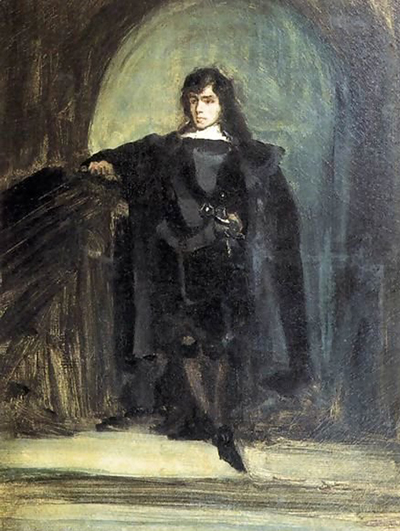Self-portrait as Ravenswood or Hamlet is the oldest portrait of Eugene Delacroix, picturing him as a young man in the early 1820s. It is intriguing to see him with such a youthful complexion.
Delacroix was an artist who took on a variety of influences during his career, with literature being a major element of that. He would study English writers for a period and Shakespeare would become one of his favourites, alongside the likes of Lord Byron. This painting can now be found at the Musée National Eugène-Delacroix in Paris and draws inspiration from one of Shakespeare's most famous plays, something that would also inspire a number of other artists from a variety of different movements. The artwork itself is fairly loose and relaxed, without quite the precision of his more famous paintings. The background, for example, is simple and also fairly rough, with the artist choosing not to add too many layers of defined content here. This might have been a stylistic decision or, alternatively, he may have wanted to produce the piece quickly.
There is a confidence in pose with Delacroix here, so clearly that characteristic of his personality was there from a young age, rather than something that developed over time as he started to achieve success as an artist. He wears a small sword around his waist as well as predominantly dark clothing. There is a yellowish tone to the light, suggeseting that we are indoors, perhaps in a small theatre. Portraiture was not a major genre for this artist but he still provides some highlights within it, such was the breadth and depth of his career over the many decades. He would often gift these items to friends, and work from the mindset of giving them something that they would appreciate, rather than necessarily producing a painting which academics would approve of. The work found here, Self-portrait as Ravenswood or Hamlet, feels a little more self-indulgent, as he enjoys the subjects that inspired him so much.
The painting is known to have had the word Ravenswood written on the back originally, leading many to assume that actually this piece was inspired by The Bride of Lammermoor, a novel from Walter Scott, who was another writer followed by Delacroix. The artist's own life also beared some similarities with the main character from this story and so it was an understandable belief at that point. In fact, it is more likely that the word was a reference to a nickname of a friend, Auguste Carrier, who was the intended recipient of the piece. There will likely remain a controversy around this in the future, as most of his own personal journals would have been studied and published by now, with little more information likely to be found on this point.




